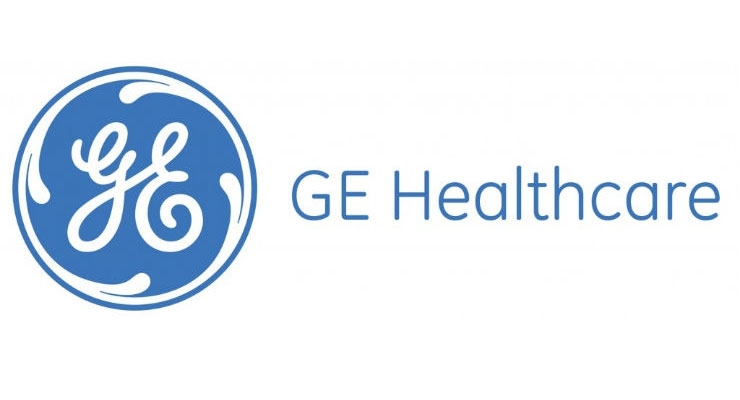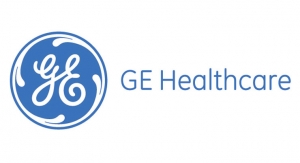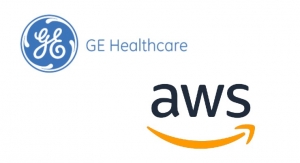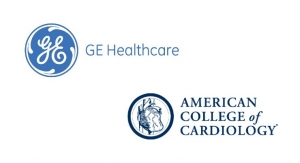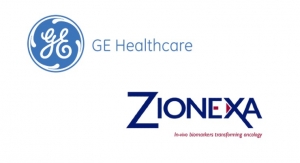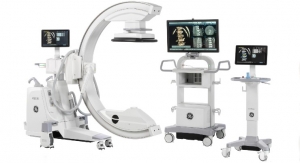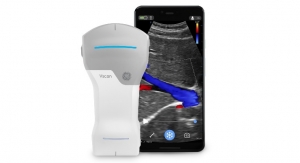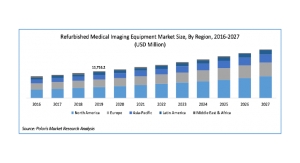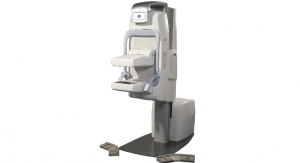07.26.17
$18.3 Billion ($123.6B total)
KEY EXECUTIVES:
John L. Flannery, Chairman and CEO, General Electric
Jeff Bornstein, Sr. VP and CFO
Kieran Murphy, President and CEO, GE Healthcare
Monish Patolawala, VP and CFO, GE Healthcare
Lee Cooper, President and CEO, U.S. and Canada
Rachel Duan, President and CEO, GE Healthcare China
Sean Burke, President and CEO, GE Healthcare Asia Pacific
Chuck Nugent, VP, Global Supply Chain
Jean-Michel Malbrancq, President and CEO, GE Healthcare Europe
Maher Abouzeid, President and CEO, GE Healthcare Eastern Growth Markets
Daurio Speranzini Jr., President and CEO, GE Healthcare Latin America
Charles Koontz, President and CEO, Healthcare IT and Chief Digital Officer
Karim Karti, President and CEO, Imaging
Terri Bresenham, President and CEO, Sustainable Healthcare Solutions
Jörg Debatin, VP and Chief Technology Officer
Laurent Dubois, CEO, GE Healthcare Partners
Anders Wold, President and CEO, Clinical Care Solutions
Thomas Mitchell, VP, Sourcing
Sue Siegel, CEO, GE Ventures and healthymagination
Thomas Westrick, VP and Chief Quality Officer
NO. OF EMPLOYEES: 54,000 (295,000 total)
GLOBAL HEADQUARTERS: Amersham, U.K.
Oct. 13, 2008.
The date stands like an ugly scar in the far corners of Diana Franklin’s mind, a constant reminder of her bitter battle for survival.
Oct. 13, 2008.
On that day, at precisely 4:45 p.m., Franklin was diagnosed with inflammatory breast cancer (IBC), an uncommon but particularly aggressive and lethal strain of the disease that tends to favor African-American women.
Oct. 13, 2008.
A difficult day, certainly, but a oddly liberating one as well.
Oct. 13, 2008.
On that day, the waiting finally ended.
“I think one of the worst parts about having cancer is the waiting game. I mean, you take all these tests and you wait, and in the meantime you’re praying the tests will be positive—for you, not for the cancer,” Franklin said in a short video posted to GE Healthcare’s website. “That’s actually the worst part—the waiting. The anxiety you have is just horrible. It’s a mind game that you play, and you can’t even enjoy life. It consumes you...”
The anxiety most definitely consumed Franklin’s existence. Most days, her breast health was all she could think about.
Thus, the diagnosis was somewhat of a relief to Franklin. She could now move forward with a treatment plan and work to restore her health.
It wouldn’t be easy, though. IBC grows and spreads quicker than more common types of breast cancer; upon diagnosis, the disease typically has already invaded other parts of the body, making it frustratingly difficult to conquer. Only 40 percent of IBC patients survive after the first five years and reoccurrence is high after the fifth year, according to statistics.
Franklin, however, was determined to beat the odds. She enlisted the help of Kristi Funk, M.D., a board-certified breast surgeon who performed a double mastectomy on actress Angelina Jolie in 2013 and treated Grammy Award-winning singer Sheryl Crow in 2006. Funk was director of patient education at Cedars-Sinai Breast Center in Los Angeles, Calif., before founding the Pink Lotus Breast Center in nearby Beverly Hills in 2007. She opened the facility in 2009, shortly before the birth of her triplet boys.
As a healthcare professional, Funk has seen more than her fair share of contestants play the cancer waiting game. During the first few years of her center’s existence, in fact, Funk was a reluctant participant in the process, inevitably scheduling biopsies weeks after inconclusive or questionable mammograms for patients with dense breasts. She yearned for a way to close the gap.
“With someone who has an abnormal mammogram, we immediately conduct an ultrasound. But if they need more [testing], even in our hands, they might have to wait a month or more to get a biopsy and results,” Funk said in the same GE Healthcare video. “In the meantime, their minds are spinning out of control. They’re literally wondering who’s going to take care of their children or their job, because that’s where a woman’s mind goes. So they’ve already leapt to the worst-case scenario.”
And Funk’s patients continued taking that leap until the center installed a SenoBright contrast enhanced spectral mammography unit from GE Healthcare in March 2012. Approved by the U.S. Food and Drug Administration (FDA) just five months before that, the machine produces digital contrast-enhanced breast images by means of an X-ray contrast agent and a dual energy acquisition technique. SenoBright uses X-rays at multiple energies to create two separate but almost simultaneous exposures that illuminate and highlight areas of iodinated contrast.
SenoBright is the answer to countless breast cancer patients’ prayers. Not only does the machine streamline the testing process, it also significantly reduces the delay between initial testing and final diagnosis. Further, it helps reduce false positive tests, and prevent unnecessary biopsies and surgeries.
“We have an arsenal of diagnostic and imaging tools at our disposal but SenoBright has filled the single biggest void, and that is how to handle an inconclusive mammogram and ultrasound expeditiously and in-house,” Funk said. “Using the same team that already knows how to implement and read mammograms, we have amazing answers within minutes. The same day we stress out a patient, we can say to her, ‘You know what? Let’s add this contrast, repeat the mammogram, and I can let you go home 10 minutes from now with answers and a plan.”
No more waiting.
“It’s really hard to put into words how technology has helped so many breast cancer survivors,” said Franklin, who now serves as operations manager at the Pink Lotus Breast Center. “To have something like SenoBright...I don’t think I can even say it without crying...When you see the look on patients’ faces when they know or don’t know and it’s almost immediate...it’s an absolute incredible device that [GE Healthcare] designed.”
Most incredible, perhaps, for its lifesaving potential. Research indicates contrast enhanced spectral mammography (CESM) improves lesion localization and is a better diagnostic tool than magnetic resonance imaging (MRI) alone. Several clinical studies, in fact, have found CESM sensitivity and testing accuracy to be consistently higher than MRI, with sensitivity averaging 100 percent and precision fluctuating between 79 percent and 80 percent (compared with 93 percent and 73 percent, respectively, for MRI exams).
Such data bodes well for the technology’s future: GE expects more than 1 million women to undergo CESM examinations with SenoBright machines through 2020, potentially impacting mammography results for nearly 250,000 patients.
ANALYST INSIGHTS: Similar to J&J, GE is another large company in a strategic flux regarding its Healthcare business. Kieran Murphy, newly appointed CEO of GE Healthcare, will be a good leader for this business unit. The real question: With the poor stock performance of GE as a whole (which has created a change in leadership at the top), does GE begin to “spin off” its business units, including Healthcare?
Paramount to GE’s lofty ambitions is its ability to adapt the wizardry and waste-no-time habits of Silicon Valley to its own evolving world of industrial manufacturing. The company has taken major steps in recent years to transform itself into a “Digital Industrial” leader by shedding its bloated finance arm, GE Capital, and more traditional businesses like water and appliances, in favor of the sensors and software that constitute the lifeblood of the industrial internet, also known as the Internet of Things.
The company ramped up its efforts considerably in 2016, investing $4 billion to enhance its analytics software and machine learning capability, and another $2 billion to improve market share in the rapidly growing additive manufacturing industry. In addition, GE launched the Industrial Internet Control System and Predix Box, devices that run algorithms and analyze data in real time to help facilitate digital connectivity, security, and computing.
GE’s long-term survival is going to depend as much on software, digital hardware, and computing systems as it does on such long-established industries as energy, transportation, and healthcare. Perhaps even more so: Championed by retiring Chairman and CEO Jeffrey R. Immelt, executives aim to transform the multinational into a “top 10 software company by 2020” in order to stake a claim in the planet’s $225 billion industrial internet market.
“[It’s] probably the most important thing I’ve worked on in my career,” Immelt told The New York Times last summer, noting the company has no contingency plans in place in case of failure. “It’s this or bust.”
Though it’s far too early to declare victory, GE is really not in any danger of going bust in its bid to dominate the digital industrial space. Though its 2016 stock prices stalled (ranging between $27.75 and $33), the company’s overall revenue rose 5.4 percent last year to $123.7 billion, and net earnings climbed out of a $6.12 billion hole from 2015 to reach $8.83 billion. Diluted net earnings rebounded as well, increasing nearly six-fold to $1.
“Your company delivered in a year of sluggish growth and geopolitical surprise. The challenge for any company is to invest in the future while delivering results,” Immelt told shareholders in a lengthy letter at the start of GE’s 2016 annual report. “We have challenged ourselves to hit aggressive financial goals as we transform GE. In 2016, we made progress on our goals...”
Indeed it did. Cash flow from operating activities surged 83 percent to $30 billion, and backlog swelled to a record $321 billion. In addition, GE returned $30.5 billion to investors through dividends and share buybacks.
The recovery was evident throughout the company, with five of GE’s seven business segments recording gains (three were double-digit hikes). Renewable Energy took the biggest leap, bounding 44 percent to $9 billion. Power was next, jumping 24.8 percent to $26.8 billion, followed by Oil & Gas, which experienced a 13.8 percent decrease in 2015 revenue and a 12 percent dropoff in profit. In 2016, that segment partially reversed its for- tunes with a 21.6 percent sales hike (to $12.9 billion), though profit tumbled 42.6 percent to $1.39 billion.
Along with growth in Aviation and Healthcare, GE’s profitable segments more than neutralized losses in Transportation and Energy Connections & Lighting, down 20.5 percent and 7.4 percent respectively. Aviation rose 6.5 percent to $26.2 billion, while Healthcare edged up 3.7 percent to $18.3 billion.
Like Oil & Gas, the Healthcare segment changed course in 2016 (year ended Dec. 31), improving its profit 9.8 percent to $3.2 billion, and increasing its profit margin a whole percentage point (17.3 percent). It also made small gains in services and equipment revenue, and boosted its total orders value by $600 million to $19.2 billion.
Executives attributed the turnaround in Healthcare mainly to technological innovation as well as demand for productivity-based tech services and IT/cloud-based solutions—further proof of software’s expanding role in the medical arena.
“If you think of [the] iPhone, its utility is fundamentally more than just the phone and camera,” newly crowned CEO John Flannery recently told the website Business Insider. “It’s all the other things that you’re able to do because of the combination of the hardware and software. And I think you’ll see the same thing in our business.”
It’s already started, actually. Building on the GE Health Cloud—an ecosystem connecting software, hardware, and medical devices—the company last year announced a next-generation IT vision for ambulatory care. Dubbed Project Northstar, the initiative combines population health, care delivery, patient engagement, and financial management in an integrated, interoperable software program. Project Northstar aims to deliver a connected workflow solution to help ambulatory providers navigate the changing landscape of value-based care while enhancing care quality and managing mixed payment models.
The company further enhanced its software and analytics prowess in 2016 through partnerships with Boston Children’s Hospital and UC San Francisco’s Center for Digital Health
Innovation.
The latter collaboration attempts to create a library of deep learning algorithms that will help clinicians make faster and more effective decisions about the diagnosis and treatment of patients with both common and complex medical conditions. The pair will integrate data from various imaging technologies (computed tomography, magnetic resonance, X-ray) as well as clinical data sets and electronic health records to develop the algorithms.
In Boston, GE is pairing its Health Cloud with the clinical knowledge of hospital radiologists to develop a decision support platform that can distinguish variability in pediatric brain MRI scans. The system will be pre-loaded with normative reference scans from children of different ages for doctors worldwide to use as a benchmark when reading pediatric brain scans.
The company is also using its Health Cloud to improve connectivity between clinicians and patients. Working with cloud-based medical imaging solutions provider Trice Imaging Inc., GE developed a program called Tricefy, which adds image sharing, diagnostic collaboration, remote review, archiving, and electronic health record integration to its Ultrasound Women’s Health product portfolio. Already available in certain countries and regions, the system enables clinicians to remotely access images and reports, and confer electronically to determine treatment.
“The GE Health Cloud will allow our partners to use machine learning to improve diagnostics and therapy,” Immelt said in the 2016 annual report. “Our competitive advantage is that GE devices produce 45 million images daily, so we are in a prime position to leverage data to improve patient outcomes.”
The company is also jockeying for a prime position in the burgeoning cell therapy sector, a market slated to be worth $10 billion by 2020 and $30 billion by 2030, assuming an average treatment cost of roughly $250,000 a patient, according to internal GE research.
Certainly, the still-evolving cell therapy field is quite a departure for GE, a company that built its empire around more traditional, well-known industries like lighting, power generation, and appliances. But executives are confident of the technology’s potential to transform healthcare.
“People are still learning, obviously,” Flannery told Reuters last summer. “But this doesn’t change our view that cell therapy is going to be fundamentally transformative in healthcare. We want to double down on life sciences, and especially so in the cell therapy business.”
GE more than doubled down in cell therapy last year, acquiring integrated cell bioprocessing systems provider Biosafe Group SA in July, and forging a licensing agreement with Vancouver-based STEMCELL Technologies Inc. in August. It also co-invested $31.5 million with the Canadian government to create a new Centre for Advanced Therapeutic Cell Technologies in Toronto (BridGE@CCRM), and through its venture capital subsidiary, launched a startup with the Mayo Clinic called Vitruvian Networks Inc., a platform company focused on accelerating access to cell and gene therapies through advanced, cloud-ready software systems and manufacturing services.
With its cell therapy investments, GE is not intending to market medicine. Rather, the company aims to offer an “end-to-end” service to pharmaceutical companies through various tools, from cell bioreactors to treatment delivery software systems.
In purchasing Biosafe, for example, GE Healthcare obtained equipment used to manufacture various cell therapies. “This more than doubles our capacity right now in cell therapy, and we think we can easily have a $1 billion-plus business in cell therapy in the next 10 years,” Flannery said in announcing the acquisition.
The STEMCELL alliance, on the other hand, allows the company to commercialize cGMP-grade versions of its partner’s T-cell reagents for isolating, activating, and culturing T-cells in clinical applications. These reagents are critical tools in developing and manufacturing cell and gene therapies for patients.
KEY EXECUTIVES:
John L. Flannery, Chairman and CEO, General Electric
Jeff Bornstein, Sr. VP and CFO
Kieran Murphy, President and CEO, GE Healthcare
Monish Patolawala, VP and CFO, GE Healthcare
Lee Cooper, President and CEO, U.S. and Canada
Rachel Duan, President and CEO, GE Healthcare China
Sean Burke, President and CEO, GE Healthcare Asia Pacific
Chuck Nugent, VP, Global Supply Chain
Jean-Michel Malbrancq, President and CEO, GE Healthcare Europe
Maher Abouzeid, President and CEO, GE Healthcare Eastern Growth Markets
Daurio Speranzini Jr., President and CEO, GE Healthcare Latin America
Charles Koontz, President and CEO, Healthcare IT and Chief Digital Officer
Karim Karti, President and CEO, Imaging
Terri Bresenham, President and CEO, Sustainable Healthcare Solutions
Jörg Debatin, VP and Chief Technology Officer
Laurent Dubois, CEO, GE Healthcare Partners
Anders Wold, President and CEO, Clinical Care Solutions
Thomas Mitchell, VP, Sourcing
Sue Siegel, CEO, GE Ventures and healthymagination
Thomas Westrick, VP and Chief Quality Officer
NO. OF EMPLOYEES: 54,000 (295,000 total)
GLOBAL HEADQUARTERS: Amersham, U.K.
Oct. 13, 2008.
The date stands like an ugly scar in the far corners of Diana Franklin’s mind, a constant reminder of her bitter battle for survival.
Oct. 13, 2008.
On that day, at precisely 4:45 p.m., Franklin was diagnosed with inflammatory breast cancer (IBC), an uncommon but particularly aggressive and lethal strain of the disease that tends to favor African-American women.
Oct. 13, 2008.
A difficult day, certainly, but a oddly liberating one as well.
Oct. 13, 2008.
On that day, the waiting finally ended.
“I think one of the worst parts about having cancer is the waiting game. I mean, you take all these tests and you wait, and in the meantime you’re praying the tests will be positive—for you, not for the cancer,” Franklin said in a short video posted to GE Healthcare’s website. “That’s actually the worst part—the waiting. The anxiety you have is just horrible. It’s a mind game that you play, and you can’t even enjoy life. It consumes you...”
The anxiety most definitely consumed Franklin’s existence. Most days, her breast health was all she could think about.
Thus, the diagnosis was somewhat of a relief to Franklin. She could now move forward with a treatment plan and work to restore her health.
It wouldn’t be easy, though. IBC grows and spreads quicker than more common types of breast cancer; upon diagnosis, the disease typically has already invaded other parts of the body, making it frustratingly difficult to conquer. Only 40 percent of IBC patients survive after the first five years and reoccurrence is high after the fifth year, according to statistics.
Franklin, however, was determined to beat the odds. She enlisted the help of Kristi Funk, M.D., a board-certified breast surgeon who performed a double mastectomy on actress Angelina Jolie in 2013 and treated Grammy Award-winning singer Sheryl Crow in 2006. Funk was director of patient education at Cedars-Sinai Breast Center in Los Angeles, Calif., before founding the Pink Lotus Breast Center in nearby Beverly Hills in 2007. She opened the facility in 2009, shortly before the birth of her triplet boys.
As a healthcare professional, Funk has seen more than her fair share of contestants play the cancer waiting game. During the first few years of her center’s existence, in fact, Funk was a reluctant participant in the process, inevitably scheduling biopsies weeks after inconclusive or questionable mammograms for patients with dense breasts. She yearned for a way to close the gap.
“With someone who has an abnormal mammogram, we immediately conduct an ultrasound. But if they need more [testing], even in our hands, they might have to wait a month or more to get a biopsy and results,” Funk said in the same GE Healthcare video. “In the meantime, their minds are spinning out of control. They’re literally wondering who’s going to take care of their children or their job, because that’s where a woman’s mind goes. So they’ve already leapt to the worst-case scenario.”
And Funk’s patients continued taking that leap until the center installed a SenoBright contrast enhanced spectral mammography unit from GE Healthcare in March 2012. Approved by the U.S. Food and Drug Administration (FDA) just five months before that, the machine produces digital contrast-enhanced breast images by means of an X-ray contrast agent and a dual energy acquisition technique. SenoBright uses X-rays at multiple energies to create two separate but almost simultaneous exposures that illuminate and highlight areas of iodinated contrast.
SenoBright is the answer to countless breast cancer patients’ prayers. Not only does the machine streamline the testing process, it also significantly reduces the delay between initial testing and final diagnosis. Further, it helps reduce false positive tests, and prevent unnecessary biopsies and surgeries.
“We have an arsenal of diagnostic and imaging tools at our disposal but SenoBright has filled the single biggest void, and that is how to handle an inconclusive mammogram and ultrasound expeditiously and in-house,” Funk said. “Using the same team that already knows how to implement and read mammograms, we have amazing answers within minutes. The same day we stress out a patient, we can say to her, ‘You know what? Let’s add this contrast, repeat the mammogram, and I can let you go home 10 minutes from now with answers and a plan.”
No more waiting.
“It’s really hard to put into words how technology has helped so many breast cancer survivors,” said Franklin, who now serves as operations manager at the Pink Lotus Breast Center. “To have something like SenoBright...I don’t think I can even say it without crying...When you see the look on patients’ faces when they know or don’t know and it’s almost immediate...it’s an absolute incredible device that [GE Healthcare] designed.”
Most incredible, perhaps, for its lifesaving potential. Research indicates contrast enhanced spectral mammography (CESM) improves lesion localization and is a better diagnostic tool than magnetic resonance imaging (MRI) alone. Several clinical studies, in fact, have found CESM sensitivity and testing accuracy to be consistently higher than MRI, with sensitivity averaging 100 percent and precision fluctuating between 79 percent and 80 percent (compared with 93 percent and 73 percent, respectively, for MRI exams).
Such data bodes well for the technology’s future: GE expects more than 1 million women to undergo CESM examinations with SenoBright machines through 2020, potentially impacting mammography results for nearly 250,000 patients.
ANALYST INSIGHTS: Similar to J&J, GE is another large company in a strategic flux regarding its Healthcare business. Kieran Murphy, newly appointed CEO of GE Healthcare, will be a good leader for this business unit. The real question: With the poor stock performance of GE as a whole (which has created a change in leadership at the top), does GE begin to “spin off” its business units, including Healthcare?
—Dave Sheppard, Co-Founder and Principal, MedWorld Advisors
Paramount to GE’s lofty ambitions is its ability to adapt the wizardry and waste-no-time habits of Silicon Valley to its own evolving world of industrial manufacturing. The company has taken major steps in recent years to transform itself into a “Digital Industrial” leader by shedding its bloated finance arm, GE Capital, and more traditional businesses like water and appliances, in favor of the sensors and software that constitute the lifeblood of the industrial internet, also known as the Internet of Things.
The company ramped up its efforts considerably in 2016, investing $4 billion to enhance its analytics software and machine learning capability, and another $2 billion to improve market share in the rapidly growing additive manufacturing industry. In addition, GE launched the Industrial Internet Control System and Predix Box, devices that run algorithms and analyze data in real time to help facilitate digital connectivity, security, and computing.
GE’s long-term survival is going to depend as much on software, digital hardware, and computing systems as it does on such long-established industries as energy, transportation, and healthcare. Perhaps even more so: Championed by retiring Chairman and CEO Jeffrey R. Immelt, executives aim to transform the multinational into a “top 10 software company by 2020” in order to stake a claim in the planet’s $225 billion industrial internet market.
“[It’s] probably the most important thing I’ve worked on in my career,” Immelt told The New York Times last summer, noting the company has no contingency plans in place in case of failure. “It’s this or bust.”
Though it’s far too early to declare victory, GE is really not in any danger of going bust in its bid to dominate the digital industrial space. Though its 2016 stock prices stalled (ranging between $27.75 and $33), the company’s overall revenue rose 5.4 percent last year to $123.7 billion, and net earnings climbed out of a $6.12 billion hole from 2015 to reach $8.83 billion. Diluted net earnings rebounded as well, increasing nearly six-fold to $1.
“Your company delivered in a year of sluggish growth and geopolitical surprise. The challenge for any company is to invest in the future while delivering results,” Immelt told shareholders in a lengthy letter at the start of GE’s 2016 annual report. “We have challenged ourselves to hit aggressive financial goals as we transform GE. In 2016, we made progress on our goals...”
Indeed it did. Cash flow from operating activities surged 83 percent to $30 billion, and backlog swelled to a record $321 billion. In addition, GE returned $30.5 billion to investors through dividends and share buybacks.
The recovery was evident throughout the company, with five of GE’s seven business segments recording gains (three were double-digit hikes). Renewable Energy took the biggest leap, bounding 44 percent to $9 billion. Power was next, jumping 24.8 percent to $26.8 billion, followed by Oil & Gas, which experienced a 13.8 percent decrease in 2015 revenue and a 12 percent dropoff in profit. In 2016, that segment partially reversed its for- tunes with a 21.6 percent sales hike (to $12.9 billion), though profit tumbled 42.6 percent to $1.39 billion.
Along with growth in Aviation and Healthcare, GE’s profitable segments more than neutralized losses in Transportation and Energy Connections & Lighting, down 20.5 percent and 7.4 percent respectively. Aviation rose 6.5 percent to $26.2 billion, while Healthcare edged up 3.7 percent to $18.3 billion.
Like Oil & Gas, the Healthcare segment changed course in 2016 (year ended Dec. 31), improving its profit 9.8 percent to $3.2 billion, and increasing its profit margin a whole percentage point (17.3 percent). It also made small gains in services and equipment revenue, and boosted its total orders value by $600 million to $19.2 billion.
Executives attributed the turnaround in Healthcare mainly to technological innovation as well as demand for productivity-based tech services and IT/cloud-based solutions—further proof of software’s expanding role in the medical arena.
“If you think of [the] iPhone, its utility is fundamentally more than just the phone and camera,” newly crowned CEO John Flannery recently told the website Business Insider. “It’s all the other things that you’re able to do because of the combination of the hardware and software. And I think you’ll see the same thing in our business.”
It’s already started, actually. Building on the GE Health Cloud—an ecosystem connecting software, hardware, and medical devices—the company last year announced a next-generation IT vision for ambulatory care. Dubbed Project Northstar, the initiative combines population health, care delivery, patient engagement, and financial management in an integrated, interoperable software program. Project Northstar aims to deliver a connected workflow solution to help ambulatory providers navigate the changing landscape of value-based care while enhancing care quality and managing mixed payment models.
The company further enhanced its software and analytics prowess in 2016 through partnerships with Boston Children’s Hospital and UC San Francisco’s Center for Digital Health
Innovation.
The latter collaboration attempts to create a library of deep learning algorithms that will help clinicians make faster and more effective decisions about the diagnosis and treatment of patients with both common and complex medical conditions. The pair will integrate data from various imaging technologies (computed tomography, magnetic resonance, X-ray) as well as clinical data sets and electronic health records to develop the algorithms.
In Boston, GE is pairing its Health Cloud with the clinical knowledge of hospital radiologists to develop a decision support platform that can distinguish variability in pediatric brain MRI scans. The system will be pre-loaded with normative reference scans from children of different ages for doctors worldwide to use as a benchmark when reading pediatric brain scans.
The company is also using its Health Cloud to improve connectivity between clinicians and patients. Working with cloud-based medical imaging solutions provider Trice Imaging Inc., GE developed a program called Tricefy, which adds image sharing, diagnostic collaboration, remote review, archiving, and electronic health record integration to its Ultrasound Women’s Health product portfolio. Already available in certain countries and regions, the system enables clinicians to remotely access images and reports, and confer electronically to determine treatment.
“The GE Health Cloud will allow our partners to use machine learning to improve diagnostics and therapy,” Immelt said in the 2016 annual report. “Our competitive advantage is that GE devices produce 45 million images daily, so we are in a prime position to leverage data to improve patient outcomes.”
The company is also jockeying for a prime position in the burgeoning cell therapy sector, a market slated to be worth $10 billion by 2020 and $30 billion by 2030, assuming an average treatment cost of roughly $250,000 a patient, according to internal GE research.
Certainly, the still-evolving cell therapy field is quite a departure for GE, a company that built its empire around more traditional, well-known industries like lighting, power generation, and appliances. But executives are confident of the technology’s potential to transform healthcare.
“People are still learning, obviously,” Flannery told Reuters last summer. “But this doesn’t change our view that cell therapy is going to be fundamentally transformative in healthcare. We want to double down on life sciences, and especially so in the cell therapy business.”
GE more than doubled down in cell therapy last year, acquiring integrated cell bioprocessing systems provider Biosafe Group SA in July, and forging a licensing agreement with Vancouver-based STEMCELL Technologies Inc. in August. It also co-invested $31.5 million with the Canadian government to create a new Centre for Advanced Therapeutic Cell Technologies in Toronto (BridGE@CCRM), and through its venture capital subsidiary, launched a startup with the Mayo Clinic called Vitruvian Networks Inc., a platform company focused on accelerating access to cell and gene therapies through advanced, cloud-ready software systems and manufacturing services.
With its cell therapy investments, GE is not intending to market medicine. Rather, the company aims to offer an “end-to-end” service to pharmaceutical companies through various tools, from cell bioreactors to treatment delivery software systems.
In purchasing Biosafe, for example, GE Healthcare obtained equipment used to manufacture various cell therapies. “This more than doubles our capacity right now in cell therapy, and we think we can easily have a $1 billion-plus business in cell therapy in the next 10 years,” Flannery said in announcing the acquisition.
The STEMCELL alliance, on the other hand, allows the company to commercialize cGMP-grade versions of its partner’s T-cell reagents for isolating, activating, and culturing T-cells in clinical applications. These reagents are critical tools in developing and manufacturing cell and gene therapies for patients.

